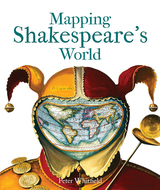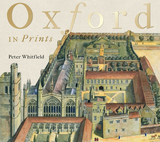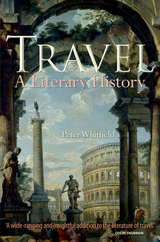3 books about Whitfield, Peter

Mapping Shakespeare's World
Peter Whitfield
Bodleian Library Publishing, 2015
Shakespeare never set a play in his own Elizabethan London. From the castle in Elsinore where Hamlet avenges his father’s death to Cleopatra’s Alexandria at the height of the Roman Empire to the seaport town in Cyprus where we await the arrival of Othello, each of Shakespeare’s plays is set in a time or space remote from his primary audience. Why is this? How much did the Bard and his contemporaries know about the foreign lands his characters often inhabit? What expectations did an audience have if the curtains rose on a play which claimed to take place in ancient Troy or the Pyrenean kingdom of Navarre in northern Spain?
Mapping Shakespeare’s World explores these questions with surprising results. It has often been said that setting is irrelevant to Shakespeare’s plays—that, wherever they are set, their enduring appeal lies in their ability to speak to broad questions of human nature. Peter Whitfield shows that, on the contrary, many of Shakespeare’s locations were carefully chosen for their ability to convey subtle meanings an Elizabethan audience would have picked up on and understood. Through the use of paintings, drawings, contemporary maps and geographical texts, Whitfield suggests answers to such questions as where Illyria was located, why The Merry Wives of Windsor could only have taken place in Windsor, and how two utterly different comedies—The Comedy of Errors and Pericles, Prince of Tyre—both came to take place in ancient Ephesus.
Just when one might think there was nothing more to be said about Shakespeare, with Mapping Shakespeare’s World, Whitfield offers a fascinating new point of view.
Mapping Shakespeare’s World explores these questions with surprising results. It has often been said that setting is irrelevant to Shakespeare’s plays—that, wherever they are set, their enduring appeal lies in their ability to speak to broad questions of human nature. Peter Whitfield shows that, on the contrary, many of Shakespeare’s locations were carefully chosen for their ability to convey subtle meanings an Elizabethan audience would have picked up on and understood. Through the use of paintings, drawings, contemporary maps and geographical texts, Whitfield suggests answers to such questions as where Illyria was located, why The Merry Wives of Windsor could only have taken place in Windsor, and how two utterly different comedies—The Comedy of Errors and Pericles, Prince of Tyre—both came to take place in ancient Ephesus.
Just when one might think there was nothing more to be said about Shakespeare, with Mapping Shakespeare’s World, Whitfield offers a fascinating new point of view.
[more]

Oxford in Prints
1675-1900
Peter Whitfield
Bodleian Library Publishing, 2016
For more than three centuries, Oxford has served as a source of inspiration for fine illustrated books and engraved prints. These works hold an important place in the historical record of the city, showing its identity to be deeply rooted in history while also chronicling Oxford’s development through the architecture of its most beautiful college and university buildings.
With Oxford in Prints, Peter Whitfield has assembled a rich selection of more than seventy illustrations and prints that offer a portrait of Oxford before it became the modern city it is today. Seventeenth-century prints by David Loggan show the medieval origins of Oxford University already overlaid by Tudor and Stuart buildings. Eighteenth-century editions of the Oxford Almanack depict a city dominated by neoclassical ideas. By the nineteenth-century, illustrations in the Almanack had an increasingly romantic feel, with buildings against a natural background of the river, trees, and sky. Each illustration or print is accompanied by an insightful description, including salient historical features.
With Oxford in Prints, Peter Whitfield has assembled a rich selection of more than seventy illustrations and prints that offer a portrait of Oxford before it became the modern city it is today. Seventeenth-century prints by David Loggan show the medieval origins of Oxford University already overlaid by Tudor and Stuart buildings. Eighteenth-century editions of the Oxford Almanack depict a city dominated by neoclassical ideas. By the nineteenth-century, illustrations in the Almanack had an increasingly romantic feel, with buildings against a natural background of the river, trees, and sky. Each illustration or print is accompanied by an insightful description, including salient historical features.
[more]

Travel
A Literary History
Peter Whitfield
Bodleian Library Publishing, 2011
Taking the form of fact-filled travelogues, stunt-writing spectaculars, or genre-blurring imaginative works, travel writing has never been more popular than it is today. But beyond the self-conscious literary artistry of today’s narratives lies a rich and well-documented history of travel writing, stretching back over several thousand years and incorporating the work of mariners and missionaries, diplomats and dilettantes alike.
From the ancient world to the present, Peter Whitfield offers the first broad survey to range over the whole history of travel writing, highlighting more than one hundred texts, including works by Marco Polo, T. E. Lawrence, Christopher Columbus, Daniel Defoe, Joseph Conrad, and Captain Cook. Whether their travels were merely for pleasure or the result of exploration, military occupation, or trade, the writers discussed here all sought to reimagine their surroundings and, through their writings, reinterpret them for the reader. Because of that personal, interpretive approach, Whitfield shows, their work inhabits a strange borderland between fact and fiction. Over time, as our travel objectives have changed, so too has the tone of travel writing, eschewing the traditional stance of cultural superiority in favor of a deeper sensitivity to other peoples and places. The book is rounded out by numerous illustrations from manuscripts and books of travel in the collection of the Bodleian Library.
A world-class examination of a little-explored genre, Travel: A Literary History offers an accessible look at the history of travel writing that will make a great addition to any carry-on.
[more]
READERS
Browse our collection.
PUBLISHERS
See BiblioVault's publisher services.
STUDENT SERVICES
Files for college accessibility offices.
UChicago Accessibility Resources
home | accessibility | search | about | contact us
BiblioVault ® 2001 - 2024
The University of Chicago Press









